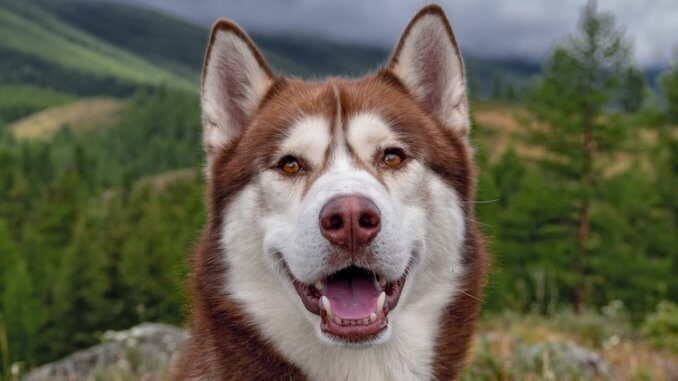
All Huskies (no matter the color) have the characteristics of true working dogs: running for hours, thriving off exercise, and requiring a job. Unfortunately, no matter how beautiful, because of their working breed bloodline, most Huskies do not fit well into many living environments due to their demands.
For instance, the Red Siberian Husky dog is known for their mischievous nature, playfulness, and high energy drive. There was one Red Husky named Blaze in my neighborhood who became a local legend for his Houdini-like escapes. Blaze’s family had a backyard fortress, yet he always found a way out to explore the neighborhood. One sunny afternoon, after another of his escapades, Blaze returned home leading a parade of local dogs he’d befriended on his journey, much to the amusement and astonishment of his family.
In this article we cover everything you need to know about the Red Husky from their history, behavior and temperament, and the most suitable home for it.
TABLE OF CONTENTS
Red Husky Quick Breed Summary
Physical Characteristics of a Red Husky
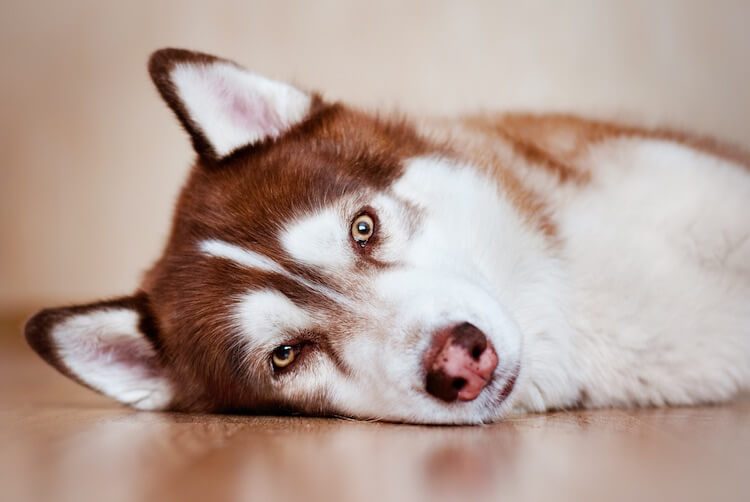
I can’t help but remember the first time I saw one. I was struck by their medium to large size, which is perfectly suited for their high energy and playfulness. It’s this size that makes them versatile companions, capable of joining you on a hike or cuddling up on the couch (if they fit!).
Height and Weight
I’ve always been fascinated by how majestic Huskies look, whether they’re bounding through snow or simply lounging in the sun. Their powerful limbs and graceful gait are a sight to behold. The females of this breed, standing at 19 to 23 inches in height and weighing between 35 and 50 pounds, are slightly smaller than their male counterparts. The males, on the other hand, boast a stature of 20 to 24 inches tall and tip the scales at 45 to 60 pounds. It’s their robust build that often has me in awe, especially when I see them in action.
Coat and Colors
Huskies wear their thick double coats like a badge of honor. It’s a testament to their sled-pulling heritage. Their undercoat is dense, providing insulation against cold temperatures, while the topcoat features longer guard hairs that protect their skin from the sun and minor scrapes. This double layer is not just functional but also incredibly soft to the touch, especially around their triangular, erect ears—which, by the way, are always listening, even when they seem like they’re ignoring you.
Their tails are another feature that captures the essence of their adaptability. Long and bushy, they sometimes use them to cover their eyes and nose while sleeping in cooler climates, a natural blanket of sorts.
But it’s their eyes that truly mesmerize. Whether amber, brown, or shades of blue, their gaze is captivating. It’s as if they’re looking right into your soul, understanding your every thought.
As for colors, while I have a soft spot for the striking reds, Huskies come in a palette that includes black, gray, sable, agouti, and, of course,white. Each color has its charm, making every Husky uniquely beautiful.
The American Kennel Club recognizes black, white, gray, sable, agouti, and red.
Red Siberian Husky Origins
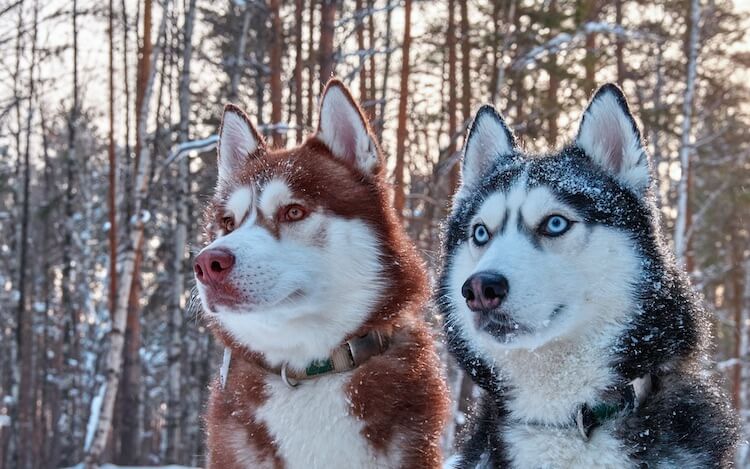
The Red Husky is not a separate dog breed from the Siberian Husky, they are simply just one of the more unique coat variations.
Growing up with a passion for dogs, my fascination with the Siberian Husky, especially the Red Husky, has only deepened over the years. These magnificent dogs have a rich history that dates back over 4,000 years, originating in North East Asia. They were not just pets but vital members of the Chukchi people in Eastern Siberia, serving as indispensable working dogs for sled-pulling and herding. This breed was revered among the Siberian communities for more than just their striking beauty; their loyalty and remarkable work ethic made them indispensable in the harsh Siberian climate.
The relationship between the Chukchi people and their dogs was built on mutual respect and necessity. The Huskies’ ability to thrive in cool climates, thanks to their thick double coat and bushy tail, made them perfectly suited to life in Eastern Siberia. But it’s not just their physical attributes that made them so valuable; it was also their spirit, companionship, and unwavering loyalty.
I learned that the pivotal moment in the breed’s history came in the 1900s during sledding races, but it was the 1925 serum run to Nome, Alaska, that truly showcased the Siberian Husky’s endurance and bravery. Their heroic efforts in delivering medication to combat a diphtheria epidemic not only saved countless lives but also earned them worldwide recognition. This event was a testament to the breed’s incredible stamina, determination, and the deep bond between dogs and humans.
Following their heroic journey in Alaska, the Siberian Husky Club of America was established in 1938, the same year the breed was recognized by the American Kennel Club. It’s a testament to their enduring appeal that today, the red Husky is ranked as the 14th most popular dog breed in the United States.
Red Siberian Husky Personality and Temperament
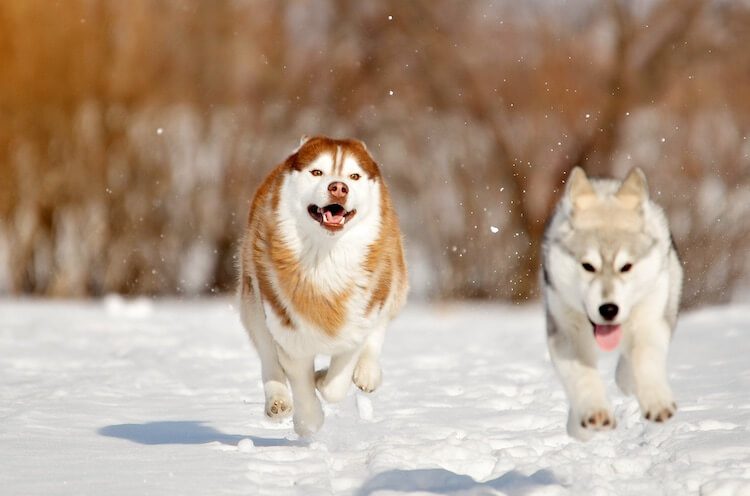
Like other Huskies, Red Huskies possess a captivating blend of traits, not least of which is their high prey drive. This inclination towards chasing smaller animals like birds, rabbits, and even cats is a testament to their ancestral lineage. While this trait can be moderated with early socialization, it’s an intrinsic part of their makeup, suggesting they might thrive best in a home without small pets.
From personal observations and the stories shared by fellow dog enthusiasts, Huskies are quite the vocalists. Their penchant for howling, a trait inherited from their wolf ancestors, is both a nod to their heritage and a form of communication. Unlike many dogs who bark, Red Huskies prefer to talk and howl, making them unique in the canine world. This doesn’t mean they’re aggressive; in fact, they’re among the least aggressive of the large dog breeds, showcasing a gentle demeanor that belies their robust appearance.
Personality-wise, the Husky is a paradox of sorts. They are mischievously free-spirited yet endearingly affectionate. This friendliness often extends to strangers, especially if they’ve been well-socialized from a young age. Despite their energetic and sometimes distractible nature, they are also incredibly loving companions who enjoy nothing more than cuddling by the fire after a day full of activities.
Compatibility with Families
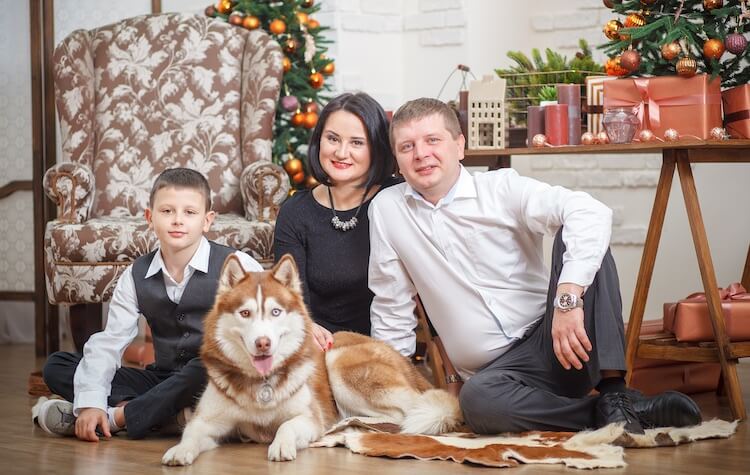
Red Huskies make beautiful family members and are both friendly and affectionate with loved ones. They can be a little stubborn and independent which means that they do require experienced owners to help them develop into a well-mannered and good natured companions for everyone in the family.
This breed is a sucker for attention and playtime; this makes them excellent companions for families with children. However, due to their independent attitude, I recommend keeping an eye on your Husky and your children while they are playing. Your Red Fur Husky should never show aggression towards children but they may get a little impatient.
Red Hair Husky Care Guide
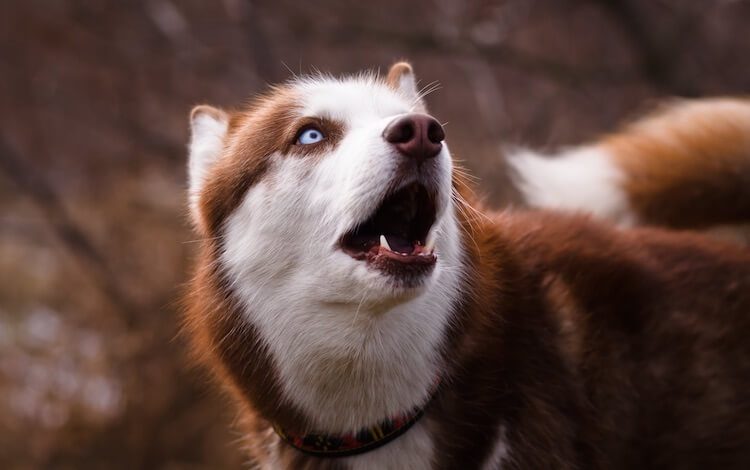
Caring for these majestic animals goes beyond providing them with food and shelter; it’s about understanding their specific requirements to ensure they lead a happy, healthy life. Drawing from my experiences and the collective wisdom of the dog-loving community, I aim to share some essential insights into the care of Red Huskies.
Feeding
I’ve learned that feeding a Husky isn’t just about the type of food but also how much and how often you feed them. This is crucial for their health, energy levels, and overall well-being. Let’s dive into some feeding guidelines that can help you navigate their nutrition through different stages of their life.
Portion Control for Puppies
Puppies have high energy needs but small stomachs. It’s important to feed them three to four times a day with portions recommended by the food manufacturer, adjusted for their expected adult size. I always advise consulting with a vet to tailor this to your puppy’s specific growth needs.
Adult Maintenance
As your Husky matures, their metabolism stabilizes, and they’ll require fewer meals. Twice a day feeding is usually sufficient for adult Huskies. It’s vital to monitor their weight and adjust food portions accordingly to prevent obesity, which can lead to health issues. I’ve found that sticking to a consistent feeding schedule helps in maintaining their ideal weight.
Senior Dogs
Older Huskies often have a decrease in energy and may require fewer calories. Adjust their food portions to maintain a healthy weight, considering their reduced activity level. Some may benefit from senior-specific dog food formulas that cater to their changing nutritional needs.
Huskies are high-energy dogs, and those that are more active may require additional calories to maintain their energy levels. If your Husky participates in activities like sledding or agility training, they might need more food. However, it’s a balance; less active Huskies will need fewer calories to avoid weight gain.
Grooming
My approach to grooming these magnificent dogs has always been rooted in understanding their specific needs and adapting my routine to meet those requirements.
Brushing
Brushing a Red Husky’s coat is crucial due to their thick double coat, which sheds heavily, especially during the spring and fall. I recommend brushing their coat at least once a week to remove loose fur and prevent matting. During shedding season, daily brushing may be necessary to manage the increased shedding. This not only helps keep their coat healthy and reduces the amount of hair around the house but also distributes natural oils across their skin and fur. Use a de-shedding tool or undercoat rake for the best results. This regular grooming ritual also strengthens the bond between you and your Husky, making it a pleasant experience for both.
Bathing
Red Huskies don’t need frequent baths due to their self-cleaning coat, which naturally repels dirt. Bathing them too often can strip their coat of natural oils, leading to dry skin. As such, bathe your Husky only when necessary, which might be just a few times a year, using a dog-specific shampoo that’s gentle on their skin. Always ensure they’re thoroughly rinsed and dried afterward to prevent any skin irritations. This infrequent bathing schedule helps maintain the natural integrity of their coat while keeping them clean.
Nail Trimming
Regular nail trimming is important to prevent discomfort and potential health issues. If you can hear their nails clicking on the floor, it’s time for a trim. I recommend a trim every 3-4 weeks, using a sharp nail clipper or grinder to avoid splitting the nail. It’s crucial to avoid the quick, which can be painful and bleed if cut. If you’re unsure about doing it yourself, seeking professional help from a groomer or vet is a good option.
Ear and Teeth Cleaning
Keeping your Husky’s ears clean and dry is essential to prevent infections, especially since they can be prone to ear problems. I suggest cleaning your Husky’s ears weekly with a vet-approved ear cleaner. Teeth cleaning is also vital for their overall health, aiming to brush their teeth several times a week with dog-specific toothpaste to prevent dental issues.
Training and Exercise
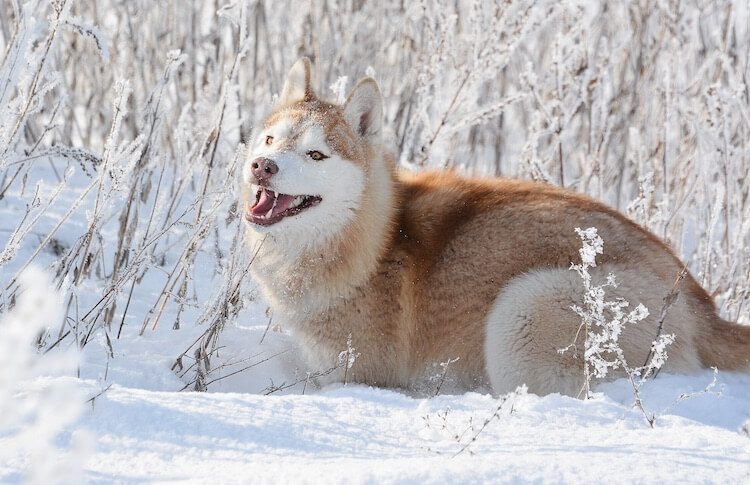
Given their high energy levels and intelligence, Red Huskies thrive on a structured regimen that balances physical activity with mental stimulation. In addition, establishing a routine that engages their body and mind from a young age is essential for a well-adjusted, happy dog. Here are some puppy training tips.
Exercise
A Siberian Husky requires ample exercise to stay healthy and content. From what I’ve observed, incorporating a variety of activities like running, playing fetch, or even agility training can significantly benefit their physical and mental health. These activities not only help in burning off their abundant energy but also in preventing boredom, which can lead to destructive behavior. Incorporating playtime with toys or other interactive games in a securely fenced area is also beneficial. Exercise sessions are opportunities for reinforcing training commands and strengthening the bond between the dog and its owner. It’s essential to adjust the intensity and duration of exercise based on the dog’s age, health, and fitness level.
Training
Training a Husky begins with consistency, patience, and positive reinforcement. They respond well to rewards-based training, where desired behaviors are rewarded with treats, praise, or play. Starting with basic commands such as sit, stay, come, and down lays the foundation for obedience. Since Huskies are known for their intelligence and sometimes stubborn streak, I find that keeping training sessions short, engaging, and fun is key to maintaining their interest. Crate training and housebreaking should begin early, using a consistent schedule and plenty of positive reinforcement. Regular training sessions help in establishing clear communication and a strong relationship between the dog and its owner.
Mental Needs
Addressing the mental needs of a Husky is just as important as their physical exercise. They are intelligent dogs that require regular mental stimulation to prevent boredom. Puzzle toys, scent work, and hide-and-seek games are excellent ways to challenge their minds. Training sessions that teach new tricks or obedience skills also contribute to their mental exercise. Providing a variety of toys and changing them frequently can keep their interest and stimulate their brain. Engaging in activities that fulfill their natural instincts, such as digging pits or agility courses, can also satisfy their mental needs while providing physical exercise.
Socialization
Socialization is crucial for a Husky puppy’s development, exposing them to different people, animals, environments, and situations from a young age. Positive and controlled exposure helps in building their confidence and reducing fearfulness or aggression. Regular visits to dog parks, puppy classes, and walks in busy areas can aid in socialization. Introducing them to various sounds, surfaces, and experiences in a safe and supportive manner is essential for their emotional development. Proper socialization results in a well-rounded, sociable dog that is comfortable in various situations and with different types of people and animals.
Husky Health Issues
Here, I’ll share some health concerns that are relatively common in all Huskies, along with Reds, along with symptoms and causes.
Hip Dysplasia
Hip dysplasia is a condition I’ve noticed comes up frequently when talking about larger breeds, including Siberian Huskies no matter their color. It’s a genetic malformation of the hip joint that can lead to arthritis or lameness. Symptoms often include difficulty in rising, reluctance to jump or run, and a noticeable change in gait. I’ve learned that maintaining a healthy weight and regular, moderate exercise can help manage this condition, though it’s important to consult a vet for a proper diagnosis and treatment plan.
Progressive Retinal Atrophy (PRA)
In my readings, Progressive Retinal Atrophy (PRA) is another health issue that Huskies can inherit. This eye condition leads to gradual deterioration of the retina and can result in blindness. Early signs include night blindness and dilated pupils that reflect more light than normal. There’s no cure for PRA, but I’ve seen that dogs can adapt well to vision loss if their environment remains consistent.
Skin Conditions
Huskies can be prone to skin conditions, such as zinc-responsive dermatosis, which I’ve learned is due to their inability to absorb zinc properly. Symptoms include hair loss, crusty skin lesions around the eyes, mouth, and ears, and lethargy. Supplementation under veterinary supervision can effectively manage this condition. It’s a reminder of the importance of a well-balanced diet and regular check-ups.
Hypothyroidism
Hypothyroidism is a condition I’ve noticed isn’t uncommon among Huskies. It occurs when the thyroid gland doesn’t produce enough hormones, affecting metabolism. Symptoms can include weight gain, lethargy, hair loss, and skin problems. Thankfully, once diagnosed, it can be easily managed with medication. Regular veterinary check-ups can catch this early, ensuring your Husky remains healthy and active.
Red Husky Puppy
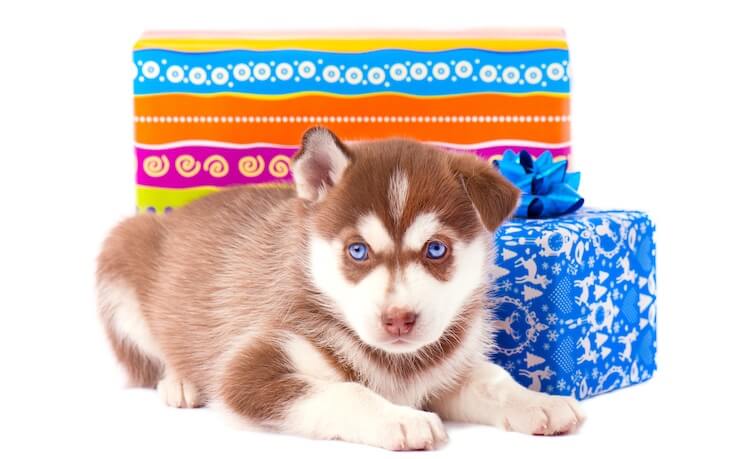
On average, a Husky will have four to six puppies per litter. How many of these puppies are red coated cannot be determined until they are born; as their coloration is due to two homozygous recessive genes. To breed a Red Husky, both parents must carry the required recessive gene.
On average the cost of a Red Husky Puppy is around $800 USD. However, this may increase to over $1,000 USD based on the breeder and the parents’ pedigree.
These puppies grow fast from birth, their growth spurt slows down as they reach maturity (at 16 months of age) and full grown size.
FAQs on the Red Husky
What is a Red Husky?
A Red Husky is a color variation of the Siberian Husky, a breed known for its endurance and willingness to work. The “red” in their name refers to the color of their coat, which ranges from a light copper to a deep, rich red. Like all Huskies, they have a thick double coat, erect triangular ears, and can have blue, brown, or bi-colored eyes.
How much exercise does a Red Husky need?
From what I’ve seen, Red Huskies are high-energy dogs that require a significant amount of exercise to stay healthy and happy. I recommend at least an hour of vigorous activity each day, such as running, hiking, or playing fetch. They also benefit from mental stimulation through training and puzzles, which can help tire them out in a different way.
Are Red Huskies good with children?
Yes, Red Huskies can be great with children. They are known for their friendly, outgoing nature. However, like with any dog, it’s crucial to supervise interactions between young children and dogs. I’ve noticed that early socialization and proper training can enhance a Husky’s gentle behavior and patience with children.
Do Red Huskies shed a lot?
In my experience, yes, Red Huskies do shed a lot. They have a thick double coat that sheds year-round and goes through a heavy shedding period, known as “blowing their coat,” once or twice a year. Regular brushing, at least once a week, can help manage the shedding and keep their coat healthy.
Can Red Huskies live in hot climates?
While Red Huskies are built for cold climates, with proper care, they can adapt to warmer environments. It’s essential to provide them with plenty of shade, air conditioning, and water to prevent overheating. I’ve learned that exercising them during the cooler parts of the day, like early morning or late evening, can help avoid heat exhaustion.
Are Red Huskies easy to train?
Red Huskies are intelligent but can be independent and stubborn, which might make training a challenge. Using positive reinforcement techniques and consistency is key. I’ve found that they respond well to rewards-based training and need a patient, firm trainer who can engage them without resorting to harsh methods.
How long do Red Huskies live?
The lifespan of a Red Husky typically ranges from 12 to 15 years. Providing a healthy diet, regular exercise, and veterinary care can help ensure they live a full, happy life. I’ve noticed that their adventurous spirit and love for activity often keep them young at heart well into their senior years.
Eye-catching and Admirable
I’ve come to understand that the Red Siberian Husky is not a breed for everyone. Their vibrant energy, mischievous antics, and free-spirited nature make them a delight to be around, but they also demand patience, understanding, and a firm hand in training. From what I’ve seen, they thrive under the care of those who appreciate their unique blend of loyalty and independence, making them ideal companions for experienced dog owners who can navigate the challenges of their training and high energy levels.
Their need for regular mental and physical stimulation means they’re best suited to active individuals or families who enjoy outdoor activities and can involve their Husky in their adventures. On the flip side, if your lifestyle is more laid back or you’re not home often, a Red Husky might find ways to entertain themselves that you might not appreciate, such as howling.

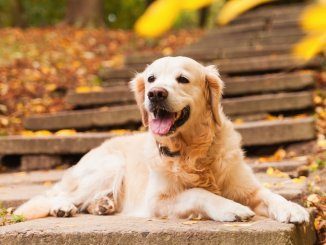
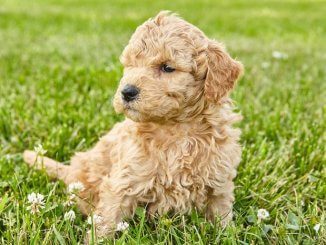
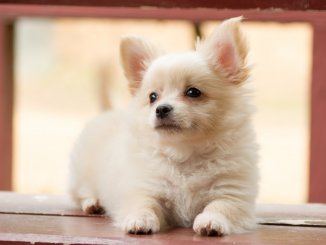
I have a red husky, he’s wonderful the best dog I’ve ever owned he’s my best friend.Such a goofball sometimes he brings me so much joy.